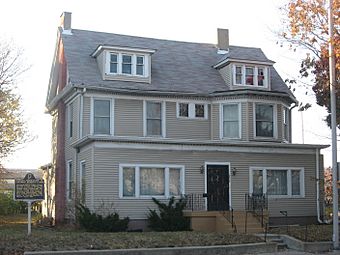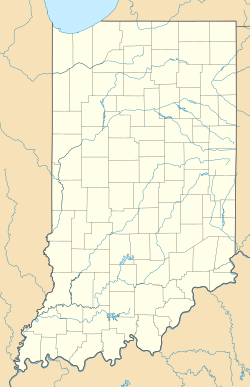Indiana State Federation of Colored Women's Clubs facts for kids
Quick facts for kids |
|
|
Indiana State Federation of Colored Women's Clubs
|
|

Indiana State Federation of Colored Women's Clubs, November 2010
|
|
| Location | 2034 North Capitol Avenue, Indianapolis, Indiana |
|---|---|
| Area | 0.5 acres (0.20 ha) |
| Built | 1897 |
| Built by | Shellhouse & Co. |
| Architectural style | Colonial Revival |
| NRHP reference No. | 87000512 |
| Added to NRHP | April 7, 1987 |
The Indiana State Federation of Colored Women's Clubs, also called the Minor House, is a historic building in Indianapolis, Indiana. It serves as the main office for a special group of African American women. This group is part of the National Association of Colored Women's Clubs.
The building itself was first built in 1897 as a home for John and Sarah Minor. But since 1927, it has been the headquarters for the Indiana State Federation of Colored Women's Clubs. This group was officially started on April 27, 1904, in Indianapolis. The building is designed in the Colonial Revival style. It has a brick base and a sloped roof with special windows called dormers. Because of its history, it was added to the National Register of Historic Places in 1987.
A local newspaper writer named Lillian Thomas Fox helped organize this group in Indiana. The Indiana group joined the National Association of Colored Women's Clubs, which started in 1896. The state group helped organize local clubs for Black women. They held yearly meetings, published a newsletter, raised money, and created a scholarship fund to help students. They also shared information about important social issues affecting Black communities in Indiana. By 1924, the Indiana group had 89 clubs with 1,670 members. Sallie Wyatt Stewart from Evansville, Indiana, led the Indiana group from 1921 to 1928. She later became the national president of the NACWC in 1928, taking over from Mary McLeod Bethune.
Club History
How the Club Started
The idea for a group of all-Black women's clubs in Indiana began after Elizabeth Lindsay Davis, a national organizer, spoke in Indianapolis on February 4, 1904. Just a few days later, on February 12, 1904, Lillian Thomas Fox helped organize a first meeting. Fox was a newspaper writer and a Black clubwoman who had started her own club in Indianapolis.
Forty-two women from fourteen different Black women's clubs in Indiana came to this meeting. They wanted to see if they could form a statewide organization. The Indiana Federation of Colored Women's Clubs was officially formed on April 27, 1904. This happened at the end of a two-day meeting in Indianapolis. Nineteen clubs and sixty-eight women attended. These clubs came from Indianapolis, Marion, South Bend, Anderson, Muncie, and Terre Haute.
The Indiana group also became part of the National Association of Colored Women's Clubs (NACWC). This national group started in 1896 and helped bring attention to the work of Black clubwomen across the country. Lillian Thomas Fox was the state organizer and honorary president for the Indiana group until she passed away in 1917.
What the Club Did
At first, the Indiana group wanted to organize Black women's clubs and share news about their activities. They also wanted to help the Black community in general. Their motto was: "Step by step we reach the heights."
Later, the group's work grew. They created a way for members to share ideas about important social issues. They worked against unfair treatment and for equal rights. They also focused on things like housing, jobs, education, and healthcare. The Indiana group collected money from members, held yearly meetings, and published a monthly newsletter called The Hoosier Woman. They even sponsored junior clubs for children and started a scholarship fund. They also helped support the Frederick Douglass National Historic Site in Washington, D.C..
Ella Herrold was the first president of the Indiana group from 1904 to 1907. Other important leaders included Minnie Scott (1907–14), Gertrude Hill (1914–21), and Sallie Wyatt Stewart (1921–28). Sallie Wyatt Stewart later became the national president of the NACWC from 1928 to 1933. She even went to an international meeting in Vienna, Austria, in 1930. Carrie Crump became president of the Indiana group in 1928.
In its early years, the Indiana group started raising money to buy its own building. Before that, the clubwomen met in each other's homes. In 1927, they bought the former home of John and Sarah Minor in Indianapolis. They finished paying for the building in 1945. To celebrate, they burned the mortgage papers on the front lawn during their yearly meeting!
Club Membership
By 1914, the Indiana group had 97 clubs and 1,568 members. By 1924, they had 89 clubs with 1,670 members. However, during the Great Depression, membership went down to 56 clubs in 1933. Membership continued to decrease in the years that followed.
The Club Building
The clubhouse was built in 1897 at 2034 North Capitol Avenue in Indianapolis. It was first a private home for John W. and Sarah P. Minor. John Minor was a lawyer who started a printing company. His wife, Sarah, and daughter lived in the home until the Indiana State Federation of Colored Women's Clubs bought it in 1927. Since then, it has been the group's main office.
The clubhouse was added to the National Register of Historic Places in 1987. In 1997, a special historical marker was placed at the site by the Indiana Historical Bureau and the Indiana Federation of Colored Women's Clubs.
The building is two and a half stories tall and made of wood. It sits on a brick base. It has a gable roof with hipped dormers (windows that stick out from the roof). There is an enclosed front porch and a two-story section at the back. The building is designed in the "T"-plan, Colonial Revival style and is covered in siding. There used to be a carriage house (a building for horse-drawn carriages) behind the property.
The front of the clubhouse has two dormer windows. The front porch has the main entrance and two large windows. The side of the building has windows and a chimney. The back of the building has another chimney, windows, and an enclosed back porch. The other side of the building has a special oriel window (a window that sticks out from the wall).
Inside the clubhouse, there is a large meeting room on the first floor. This room has two fireplaces. The building also has two stairways, one at the front and one at the back.




